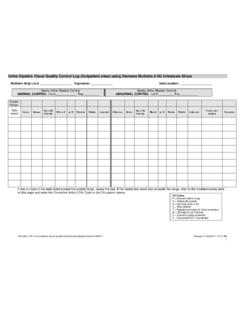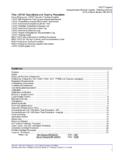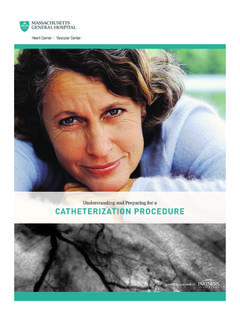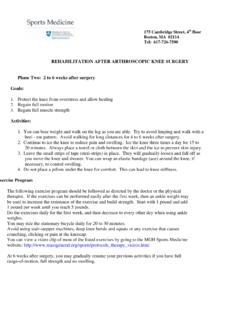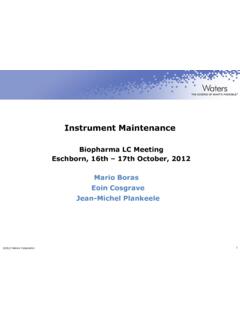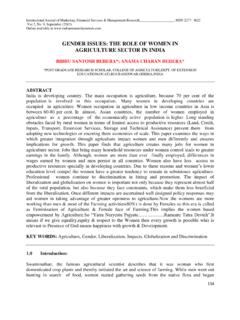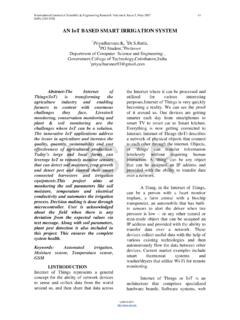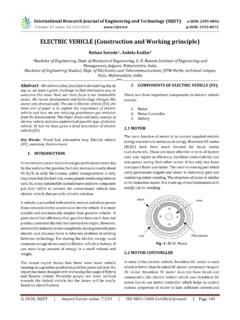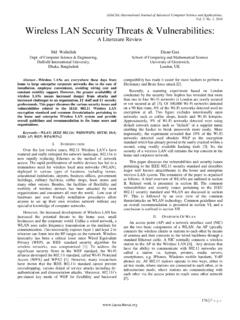Transcription of Rehabilitation Protocol for PCL Reconstruction
1 Rehabilitation Protocol for PCL Reconstruction This Protocol is intended to guide clinicians through the post-operative course for PCL Reconstruction . This Protocol is time based (dependent on tissue healing) as well as criterion based. Specific intervention should be based on the needs of the individual and should consider exam findings and clinical decision making. The timeframes for expected outcomes contained within this guideline may vary based on surgeon s preference, additional procedures performed, and/or complications. If a clinician requires assistance in the progression of a post-operative patient, they should consult with the referring surgeon. The interventions included within this Protocol are not intended to be an inclusive list.
2 Therapeutic interventions should be included and modified based on the progress of the patient and under the discretion of the clinician. Post-operative considerations If the patient develops a fever, unresolving numbness/tingling, excessive drainage from the incision, uncontrolled pain or any other symptoms you have concerns about you should contact the referring physician. P HA SE I: IMMED IA TE P OST-OP P HA SE (0-4 W EEKS AF TER SURG ERY ) Rehabilitation Goals Protect graft Reduce swelling, minimize pain Restore patellar mobility Restore full extension, gradually improve flexion Minimize arthrogenic muscle inhibition, re-establish quad control , regain full active extension Patient education o Keep your knee straight and elevated when sitting or laying down o Support the entire limb when extended o Do not pivot on your surgical side o Return to driving.
3 6-8 weeks post-op Weight Bearing Partial Weight Bearing (PWB) with crutches, braced locked in extension with all ambulation and sleeping Precautions Avoid hamstring activation or guarding Avoid hyperextension activities Prevent posterior tibial translation Intervention Swelling Management Ice, compression, elevation (check with MD re: cold therapy) Retrograde massage Range of motion/Mobility Gentle PROM *avoid hamstring guarding Patellar Mobilizations: superior/inferior and medial/lateral Seated active-assisted knee flexion Therapeutic Exercise Ankle pumps Quadriceps sets Straight leg raise (SLR) Sidelying and standing hip abduction/adduction Standing hip extension from neutral Resisted plantarflexion in long sitting, progressing to standing calf raise with full knee extension Functional electrical stimulation (as needed for trace to poor quadriceps control ) Mas s a ch u s etts G en era l Br ig h am S p o rts Me d icin e 2 Criteria to Progress Good quadriceps control (no lag with SLR) Full knee extension >60 degrees of knee flexion PROM No signs of active inflammation P HA SE II.
4 P ROTEC TION P HA SE (4-1 2 W EEKS A F TER SURG ERY ) Rehabilitation Goals Increase knee ROM, particularly flexion Normalize gait Improve quadriceps strength and hamstring flexibility Weight Bearing During this phase, the brace is progressively unlocked (when able to perform SLR) and weight bearing increased: Weeks 4-6: WBAT with crutches, brace unlocked for gait in controlled environment only Weeks 6-8: WBAT with crutches, brace unlocked for all activities Week 8: brace discontinued (as allowed by surgeon). Patient may discontinue crutches if they demonstrate the following: o No quadriceps lag with SLR o Full knee extension o Knee flexion AROM 90-100 degrees o Normal gait pattern (may use 1 crutch/cane until gait normalized) Precautions Avoid hamstring activation or guarding Avoid hyperextension activities Prevent posterior tibial translation Additional Interventions *Continue with Phase I interventions as indicated Therapeutic Exercise: exercise progressions below should be in respect to timeline of healing as well as patient ability to perform appropriately, if unable to perform with proper form, delay adding to program Weeks 4-8.
5 Wall slides (0-45 degrees knee flexion) Leg press (0-60 degrees knee flexion) Standing 4 way hip exercise for resisted hip flexion, extension, abduction, and adduction. Place resistance above knee for hip abduction and adduction Sidelying hip external rotation-clamshell Hooklying transversus abdominus progression Weeks 8-12: Stationary bike (foot placed forward on pedal without use of toe clips to minimize hamstring activity, seat height slightly higher than normal), Elliptical trainer Gait training over level ground Closed kinetic chain terminal knee extension using resistance band or weight machine Mini squats (0-90 degrees knee flexion) Leg press (0-90 degrees knee flexion) Seated calf raises Balance/Proprioception Single leg standing balance (knee slightly flexed) static progressed to dynamic and level progressed to unsteady surface Criteria to Progress No effusion/swelling/pain after exercise Normal gait ROM equal to contra lateral side P HA SE III.
6 L ATE P OST-OP (3-6 MON THS A FTER SURG ERY ) Rehabilitation Goals Safely progress strengthening Promote proper movement patterns Avoid post exercise pain/swelling Mas s a ch u s etts G en era l Br ig h am S p o rts Me d icin e 3 Additional Interventions *Continue with Phase I-II Interventions as indicated Strengthening Gym equipment: leg press machine, hip abductor and adductor machine, hip extension machine, roman chair, seated calf machine **The following exercises to focus on proper control with emphasis on good proximal stability Squat to chair Lateral lunges Romanian dead lift Single leg progression: o Single leg press, slide board lunges: retro and lateral, step ups with march, lateral step-ups, step downs, single leg squats, single leg wall slides Knee exercises for additional exercises Bridges & single leg bridges Balance/Proprioception Lateral step overs Joint position sense Progress single limb balance including perturbation training Conditioning Treadmill walking Jogging in pool with vest or belt Swimming (no breast stroke or frog kick ) Criteria to Progress Clearance by surgeon to resume full or modified activity Full, pain-free AROM and PROM, muscle strength and endurance, and proprioception Quadriceps/HS/Hip strength 80% of uninvolved leg measured with hand-held dynamometer (HHD) P HA SE IV.
7 AD V AN C ED STREN G THEN IN G A ND EA RL Y RETURN TO SP ORT (6-9 MON THS A F TER SURG ERY) Rehabilitation Goals Safe and gradual return to work or athletic participation Patient education on possible limitations, with patient demonstrating clear understanding maintenance of strength, endurance, and function Safely initiate sport specific training program Additional Interventions *Continue with Phase II-III interventions as indicated Therapeutic Exercise Continue closed kinetic chain exercise progression Interval running program o Return to Running Program Progress to plyometric and agility program (with functional brace if prescribed) o Agility and Plyometric Program Criteria to Progress Clearance from MD and ALL milestone criteria below have been met Completion jog/run program without pain/effusion/swelling Functional Assessment o Quad/HS/glut index 90%.
8 HHD mean or isokinetic testing @ 60d/s o Hamstring/Quad ratio 66% o Hop Testing 90% compared to contra lateral side, demonstrating good landing mechanics KOOS-sports questionnaire >90% International Knee Committee Subjective Knee Evaluation >93 Psych Readiness to Return to Sport (PRRS) P HA SE V : UN RESTRIC TED RETURN TO SP ORT (9+ MON THS A F TER SURG ERY ) Rehabilitation Goals Continue strengthening and proprioceptive exercises Symmetrical performance with sport specific drills Safely progress to full sport Mas s a ch u s etts G en era l Br ig h am S p o rts Me d icin e 4 Additional Interventions *Continue with Phase II-IV interventions as indicated Multi-plane sport specific plyometrics program Multi-plane sport specific agility program Include hard cutting and pivoting depending on the individuals goals Non-contact practice Full practice Full play Discharge Criteria Successful completion of all phases of Rehabilitation and independent home exercise program/progression established.
9 For the recreational or competitive athlete, return-to-sport decision making should be individualized and based upon factors including but not limited to previous injury history, the level of demand on the lower extremity, contact vs non-contact, and frequency of participation. Close discussion with the referring surgeon is strongly recommended prior to advancing to a return-to-sport Rehabilitation program. Revised 10/2021 Contact Please email with questions specific to this Protocol References: 1. de Paula Leite Cury, R., Kiyomoto, H., Rosal, G., Bryk, F., de Oliveira, V. and de Camargo, O., 2012. Rehabilitation Protocol AFTER ISOLATED POSTERIOR CRUCIATE LIGAMENT Reconstruction . Revista Brasileira de Ortopedia (English Edition), 47(4), 2.
10 Hammoud, S., Reinhardt, K. and Marx, R., 2010. Outcomes of Posterior Cruciate Ligament Treatment: A Review of the Evidence. Sports Medicine and Arthroscopy Review, 18(4), 3. Lien, O., Aas, E., Johansen, S., Ludvigsen, T., Figved, W. and Engebretsen, L., 2010. Clinical outcome after Reconstruction for isolated posterior cruciate ligament injury. Knee Surgery, Sports Traumatology, Arthroscopy, 18(11), 4. Pierce, C., O Brien, L., Griffin, L. and LaPrade, R., 2012. Posterior cruciate ligament tears: functional and postoperative Rehabilitation . Knee Surgery, Sports Traumatology, Arthroscopy, 21(5), 5. Quelard, B., Sonnery-Cottet, B., Zayni, R., Badet, R., Fournier, Y., Hager, J. and Chambat, P., 2010. Isolated posterior cruciate ligament Reconstruction : Is non-aggressive Rehabilitation the right Protocol ?
